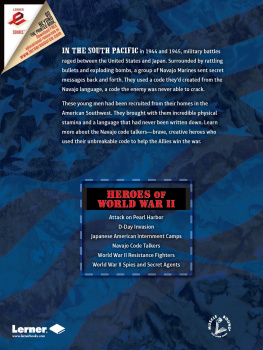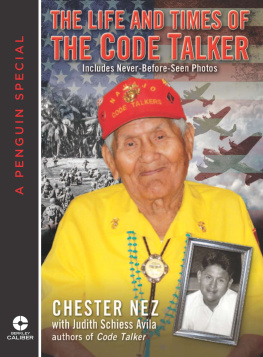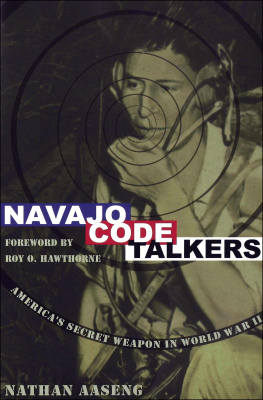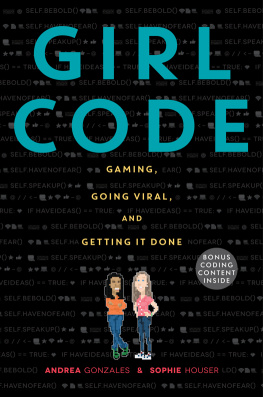Sioux
Code Talkers
of World War II
Sioux
Code Talkers
of World War II
Andrea M. Page
PELICAN PUBLISHING COMPANY
Gretna 2017
Copyright 2017
By Andrea M. Page
All rights reserved
The word Pelican and the depiction of a pelican are
trademarks of Pelican Publishing Company, Inc., and are
registered in the U.S. Patent and Trademark Office.
Library of Congress Cataloging-in-Publication Data
Names: Page, Andrea M., author.
Title: Sioux code talkers of World War II / Andrea M. Page.
Description: Gretna, LA : Pelican Publishing Company, [2017] | Includes
bibliographical references and index. | Audience: Grades 4-6.
Identifiers: LCCN 2016026431| ISBN 9781455622436 (hardcover : alk. paper) |
ISBN 9781455622443 (e-book)
Subjects: LCSH: World War, 1939-1945CryptographyJuvenile literature. |
Indian code talkers Juvenile literature. | Dakota IndiansJuvenile
literature. | World War, 1939-1945Participation, IndianJuvenile
literature. | United StatesArmed ForcesIndiansJuvenile literature. |
Indians of North AmericaHistory20th centuryJuvenile literature.
Classification: LCC D810.C88 P34 2016 | DDC 940.54/8673dc23 LC record available at https://lccn.loc.gov/2016026431
Printed in the United States of America
Published by Pelican Publishing Company, Inc.
1000 Burmaster Street, Gretna, Louisiana 70053
For John Bear King, the Sioux Code Talkers, and the members of the 302nd Reconnaissance Troop, who served our country with honor.
For my uncle Claude Black Cloud, who enlisted in the army during the Vietnam War and is a role model for bravery, fortitude, generosity, and wisdom.
For my family members who serve(d) our country, including my brother, Jerry Monsees, and more than sixteen cousins, nieces, nephews, uncles, and an aunt from the Black Cloud/Monsees and Munn/Page families.
For John Jack Gibbons Langan, who inspired me to persevere and explore the unknown.
For my parents, Walter and Mary Monsees, who always believed in me and never let me give up.
Mitakuye Oyasin
Lakota greeting meaning all are my relations
I grew up with rules. Of course these included the usual rules of chores, cooperating with my siblings, and trying my best at school. But one main rule was drilled into our heads as children more than any other: respect your elders. I didnt grasp the entire concept of this type of relationship with my elders until adulthood. I was always courteous and caring around my aunts, uncles, and grandparents, but I learned the most profound lesson of respecting my elders in 1994, when I began researching the military service of my great-uncle John Bear King. I am forever changed and deeply honored to be connected to the elders in my tiyospaye (family community), my ancestors, and my friends who have shared this journey with me. This book is a culmination of my research of the Lakota Code Talkers service in the First Cavalry Division during World War II.
I was never fascinated by history while growing up in Rochester, New York. When I was young, I struggled to communicate through writing. I was very shy and afraid to share my thoughts. In fact, it wasnt until college that I had a suitemate sit down with me and teach me proper writing techniques. My sentence structure was all mixed up. I realize now that I struggled because English was a second language for both of my parents.
My mother was born and raised on the Standing Rock Sioux Reservation in South Dakota, and my father was born and raised in Germany. We spoke English at home, but Im sure it wasnt perfect, perhaps with a verb out of place here and there (syntax like that was perfectly fine in my parents native tongues of Lakota and German). However, these challenges never stopped me from dreaming of becoming a childrens author.
One day a newspaper article and photo arrived in the mail, sent by a cousin in my mothers hometown of Kenel, located on the Standing Rock Reservation. The World War II-era photo included my mothers uncle John Bear King and five other men who, according to the article, served in the First Cavalry Division. The reporter, Avis Little Eagle, had interviewed the last surviving man in the picture. The veteran revealed a secret he had been holding on to for fifty years: those six men and one other who was missing from the photo were Indian Code Talkers.
I witnessed Mom open the envelope and read the note and article at her kitchen table. We had no idea what code talking was at the time. I was a teacher by then, so I brought the article into my classroom to share with my students and colleagues. I knew the story was important enough to warrant some digging. I wanted to make sure our familys history was documented for my daughters. What I didnt realize that day was how long it would take me to verify and document the fact that my great-uncle John Bear King was a Code Talker in World War II.
I started with the first bit of factual information I had: the reporters name. I phoned her and asked a few questions and received the contact information of the man she interviewed. I called Philip Stoney LaBlanc several times, interviewing him about his experience. He was in his late seventies or early eighties, so his memory was dim on certain details. Looking back, I probably wasnt asking the right questions. I knew very little about the war and code talking. I moved on to another approach and searched the library. I looked in the reference section and found... nothing. I turned to the local veterans office, where veterans service administrator John Edmunds provided me with an address for the First Cavalry Association offices in Texas. I wrote an ad for their newsletter asking for help, and lo and behold, someone answered. John Gibbons Langan, nicknamed Jack, sent me a letter confirming that code talking was used in World War II and that he witnessed it.
Jack was a writer, a journalist, and a guide at Yellowstone National Park. We corresponded by phone and by mail for a time, and then my mom and I traveled to Jackson Hole, Wyoming, to meet him in person. He shared photocopied records, articles, and maps he had collected over the years. Jack also announced that he had two goals for me as I began this project. You should learn the [Lakota] language, he told me first. Then he said, You must set the record straight.
I stayed in touch with Jack after we left Wyoming. With each phone call and letter, he insisted, Set the record straight. I admit I didnt really understand what that would entail. I had no idea that I was about to embark on a twenty-year journey.
Shortly after meeting with Jack, the Internet become a popular search tool, so I posted on forums and sent emails. I went back to the library and ordered books on the First Cavalry Division in World War II through Interlibrary Loan. I followed trails of breadcrumbs wherever I could find them. When I learned the First Cavalry Division Association was having a reunion in Buffalo, New York, my uncle Claude Black Cloud and I drove to meet Capt. Donald Walton of the 302nd Reconnaissance Troop, who was Great-Uncle John Bear Kings commanding officer. On a different trip, my mom and I visited the National Archives in Washington, DC, and I made copies of everything I could get my hands on in the First Cavalry World War II files. I pored over boxes and papers and maps and photosshelves upon shelves of documents.













